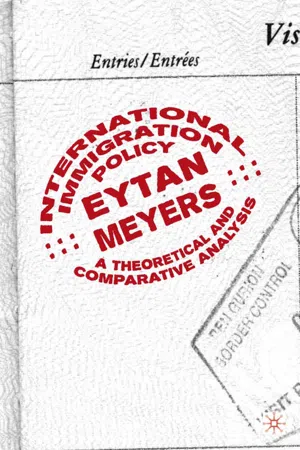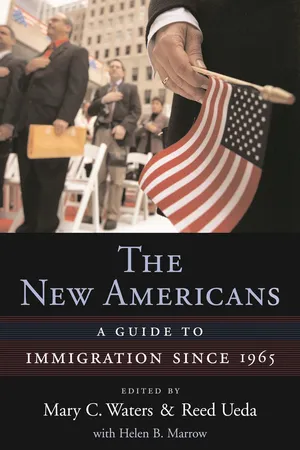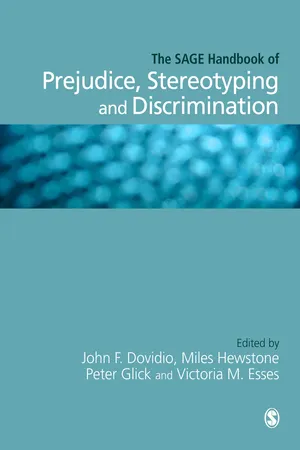History
Anti-Immigration Policies
Anti-immigration policies refer to government regulations and actions aimed at restricting or controlling the influx of immigrants into a country. These policies can take various forms, such as border controls, visa restrictions, and deportation measures. Throughout history, anti-immigration policies have been implemented for reasons including economic protectionism, national security concerns, and cultural preservation.
Written by Perlego with AI-assistance
Related key terms
1 of 5
3 Key excerpts on "Anti-Immigration Policies"
- eBook - PDF
International Immigration Policy
A Theoretical and Comparative Analysis
- Eytan Meyers(Author)
- 2004(Publication Date)
- Palgrave Macmillan(Publisher)
The workers in low-paying jobs limit their opposition to immigration because the inflow of immigrants into these jobs allows them to climb the social and professional ladder. The government, faced with pressures for additional migrants on the part of the employers, liberalizes immigration policy. The state of the economy sometimes also influences immigration policy through the partisan channel. Economic crises produce dissatisfaction with government policies and increase the support for extremist parties, including (but not restricted to) anti-immigration parties. The latter 12 ● International Immigration Policy especially benefit from such protest voting during periods of large dissim- ilar immigration. The state of the economy, and in particular the state of the labor market, will be measured in this study in terms of the annual unemployment rate. Hypothesis 2 Large-scale immigration of dissimilar racial or ethnic composition contributes to restrictions on immigration (in terms of size and composition of immigration). The second important factor contributing to restrictions on immigration is opposition to large-scale immigration of dissimilar racial/ethnic/cultural composition (when compared to the racial/ethnic/ cultural composition of the receiving society or of its dominant element). 18 This hypothesis relates to culture-based theories, which see racism as a response to what is strange and unfamiliar, and as challenges to the racial status quo in the society. Studies have demonstrated that the native population tends to judge immigrants according to the degree to which they diverge from the dominant norm according to racial, ethnic, and cultural terms. In the United States, for example, the dominant norm has been WASP, leading to a preference ordering: Anglo, Germans, Slavs, Southern Europeans (French, Italians, and Spaniards), Jews, Latinos and Asians, African. - eBook - PDF
The New Americans
A Guide to Immigration since 1965
- Mary C. Waters, Reed Ueda, Mary C. Waters, Reed Ueda, Helen B. Marrow(Authors)
- 2009(Publication Date)
- Harvard University Press(Publisher)
Immigration Control Policy: Law and Implementation Aristide R. Zolberg As of the mid-20th century, the United States was no longer a “nation of immi-grants” except in collective memory, as the proportion of foreign-born people had fallen to approximately 5 percent. This reflected a deliberate political choice en-acted in the 1920s through legislation that drastically reduced annual “main gate” immigration from Europe and established national-origins quotas designed to re-store the country’s pre–Civil War ethnic profile. The principal targets were eastern and southern Europeans, whose assimilation was considered problematic, as well as Asians, deemed unacceptable. The policy was implemented through “remote con-trol” of the country’s sea borders by requiring immigrants to obtain visas from American consulates before embarking. This created a distinction between visitors and immigrants, utilizing shipping lines to enforce the regulations. Because immigration policy involves distinct economic and identity consider-ations, its political dynamics straddle the conventional left-right divide and foster unusual coalitions. The restrictionist regime was imposed by a broad alliance of cul-tural conservatives, consisting mainly of Republicans and southern Democrats, who concurrently imposed Prohibition, promoted an assertively patriotic public culture, and reinforced racial segregation and social discrimination; it was also supported by organized labor. The opposition included the targeted immigrant groups, concen-trated in urban constituencies, as well as industrialists and agricultural entrepre-neurs concerned with maintaining an ample labor supply. - John F Dovidio, Miles Hewstone, Peter Glick, Victoria M Esses, John F Dovidio, Miles Hewstone, Peter Glick, Victoria M Esses, SAGE Publications Ltd(Authors)
- 2010(Publication Date)
- SAGE Publications Ltd(Publisher)
22 Anti-Immigration Bias Ulrich Wagner, Oliver Christ, and Wilhelm Heitmeyer ABSTRACT Migrants, especially those who cross national state boarders, become targets of political debates, often involving derogation of immigrants, and both discrimination and violence against them. This chapter starts with a brief look at the history of bias against immigrants and the history of the accompanying social psychological research. We then present the currently most prominent explanatory concepts for anti-immigrant bias, such as intergroup competition, threat, and emotions as well as national identification. Social psychological processes are embedded in and moderated by societal variables. A multilevel model of social context and psychological influences describes how societal variables affect the influence of social psychological processes on bias against immigrants. The chapter ends with a description of means to prevent and reduce bias against immigrants, followed by some recommendations for expanding future research by taking the needs of both the receiving society and migrants into account. ANTI-IMMIGRATION BIAS Migration is a central characteristic of the modern world (Adler & Gielen, 2003). Many countries, particularly in Western Europe as well as in traditional immigration countries such as the United States and Canada, are facing an increasing inflow of different immigrant groups (Pettigrew, 1998a). The integration of immigrants into society is a challenge for both immigrants and host societies. This is one of the reasons why the issues of immigration and multiculturalism are major topics in political and public debate. Cross-culturally, immigrants face negative attitudes (e.g., Dovidio & Esses, 2001; Duckitt, 1993; Heitmeyer, 2002; Pettigrew, Jackson, Ben Brika, et al., 1998; Scheepers, Gijsberts, & Coenders, 2002) and negative stereotypes (Lee & Fiske, 2006) in host countries.
Index pages curate the most relevant extracts from our library of academic textbooks. They’ve been created using an in-house natural language model (NLM), each adding context and meaning to key research topics.


